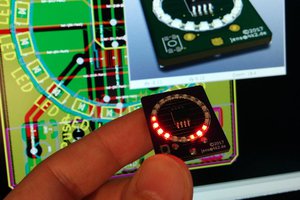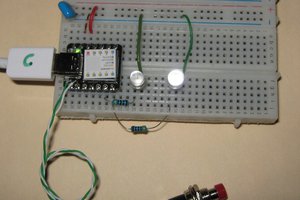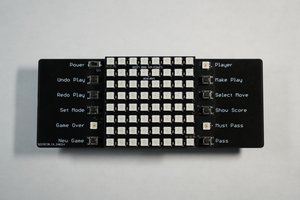TLDR Preview
Overview of Prototype V1
Overview of Prototype V2
How it's done
In the development of this project, STM32 CubeMX and CubeIDE were used to configure and generate the HAL (hardware-abstraction-layer). Some says I'm cheating and using a code generator. I don't disagree XD.
To edit/compile/flash the code you only need to install CubeIDE. Although feel free to use any tools you like. You can download CubeIDE here: https://www.st.com/en/development-tools/stm32cubeide.html
The intricacies of animating 64 LEDs with Timer16
The clock is set to 8Mhz and the timer16 counter is set to 1000 (see "tim.c"). Thus 8Mhz/1000=8Khz. The timer runs at 8khz. It updates a new LED 8000 cycles per second.
Analogy
Imagine there is a cursor that is moving left to right, top to bottom. Every cycle, the cursor moves to the next LED, reads the buffer and decides if the LED should be on/off. In other words, it takes 64 cycles to update the full screen since there is 64 LEDs. Consequently, it takes 8000Hz/64LEDs = 125ms to update the full screen.
Where is the timer handler?
The timer handler function "HAL_TIM_PeriodElapsedCallback()" is called in the file "stm32f0xx_it.c". At that location the "screen_interruptUpdate()" function is called to update the next LED.
About LED Matrix
The chip we are using is the STM32F0. The datasheet indicates that the maximum current through a whole GPIO PORT is 30mA. The LEDs are running at 20mA with the chosen current limit resistor. Therefore, the code is set to only turn on 1 single LED at a time in order to satisfy that requirement. Since the whole screen is updated every 125ms, there is enough persistence of vision to produce a consistent animation.
The low-level function which controls the individual LEDs is located in "ledHandler.c". The function "matrix_setLed_on()" is used to enable an LED. It can be seen that at the beginning of it, it calls "matrix_setLed_allOff()" to disable any previous LEDs and ensure the PORT never source more than 30mA.
About screenBuffer.c
The screenBuffer is how you interact with the LED matrix. There is 1 main fundamental fonction you need:
- screen_set_bit(row, column, state)
This is function set the state of each LEDs in the 8x8 matrix. It's either 1 (on) or 0 (off).
Additionally, there are helper functions to make animating easier:
- screen_get_bit()
- screen_fill()
- screen_clear()
How to Flash
Things you need:
- ST-Link - I personally use an STM32F0 Nucleo Board: 497-15096-ND
- Female Connector: H2193-ND
- Male Connector: H2181-ND
- Precrimped wires x4: H4BXG-10112-B8-ND
Instruction
- Connect the ST-Link SWD header to the PCB's programming port
- Compile the code in STM CubeIDE: "Project"->"Build All"
- Connect your Nucleo board to your computer
- Configure the debugger as follows: "Run" -> "Debug Configurations"
- Flash the firmware: "Run" -> "Run"
- You will see this in the logs
Memory Programming ... Opening and parsing file: ST-LINK_GDB_server_a15460.srec File : ST-LINK_GDB_server_a15460.srec Size : 21.34 KB Address : 0x08000000 Erasing memory corresponding to segment 0: Erasing internal memory sectors [0 21] Download in Progress: File download complete Time elapsed during download operation: 00:00:01.454 Verifying ... Download verified successfully Shutting down... Exit.- You might have to power cycle the PCB to get the firmware started the first time
- Congrats, you have flashed the addon. Happy coding.
 LambertTheMaker
LambertTheMaker
 Jens Hauke
Jens Hauke
 Corey Benn
Corey Benn
